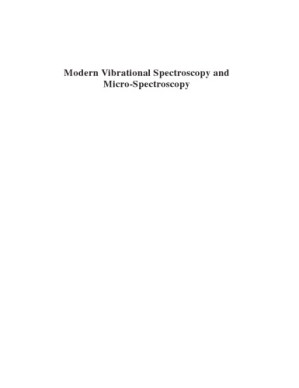English [en], .pdf, 🚀/lgli/lgrs/nexusstc/scihub/zlib, 8.6MB, 📘 Book (non-fiction), nexusstc/Modern Vibrational Spectroscopy and Micro‐Spectroscopy: Theory, Instrumentation and Biomedical Applications/e65d4e50a7ec98329ca1e94c92b976b0.pdf
Modern vibrational spectroscopy and micro-spectroscopy : theory, instrumentation, and biomedical applications 🔍
John Wiley & Sons, Incorporated, 1, 2015
Max Diem 🔍
description
Modern Vibrational Spectroscopy and Micro-Spectroscopy: Theory, Instrumentation and Biomedical Applications unites the theory and background of conventional vibrational spectroscopy with the principles of microspectroscopy. It starts with basic theory as it applies to small molecules and then expands it to include the large biomolecules which are the main topic of the book with an emphasis on practical experiments, results analysis and medical and diagnostic applications. This book is unique in that it addresses both the parent spectroscopy and the microspectroscopic aspects in one volume. Part I covers the basic theory, principles and instrumentation of classical vibrational, infrared and Raman spectroscopy. It is aimed at researchers with a background in chemistry and physics, and is presented at the level suitable for first year graduate students. The latter half of Part I is devoted to more novel subjects in vibrational spectroscopy, such as resonance and non-linear Raman effects, vibrational optical activity, time resolved spectroscopy and computational methods. Thus, Part 1 represents a short course into modern vibrational spectroscopy. Part II is devoted in its entirety to applications of vibrational spectroscopic techniques to biophysical and bio-structural research, and the more recent extension of vibrational spectroscopy to microscopic data acquisition. Vibrational microscopy (or microspectroscopy) has opened entirely new avenues toward applications in the biomedical sciences, and has created new research fields collectively referred to as Spectral Cytopathology (SCP) and Spectral Histopathology (SHP). In order to fully exploit the information contained in the micro-spectral datasets, methods of multivariate analysis need to be employed. These methods, along with representative results of both SCP and SHP are presented and discussed in detail in Part II.
Alternative filename
lgrsnf/Diem - Modern Vibrational Spectroscopy and Micro-Spectroscopy.pdf
Alternative filename
lgli/Diem - Modern Vibrational Spectroscopy and Micro-Spectroscopy.pdf
Alternative filename
scihub/10.1002/9781118824924.pdf
Alternative title
Modern vibrational spectroscopy & micro spectroscopy theory, instrumentation & biomedical applications
Alternative title
Modern Vibrational Spectroscopy and Micro Spectroscopy
Alternative author
Diem, Max
Alternative publisher
Wiley & Sons, Limited, John
Alternative edition
Online access with DDA: Askews (Medicine), Chichester, West Sussex, 2015
Alternative edition
John Wiley & Sons, Inc., Chichester, West Sussex, 2015
Alternative edition
United States, United States of America
Alternative edition
Chichester, West Sussex, England, 2015
Alternative edition
Chichester, West Sussex, UK, 2015
metadata comments
0
metadata comments
lg1402303
metadata comments
{"edition":"1","isbns":["1118824865","111882492X","9781118824863","9781118824924"],"last_page":430,"publisher":"Wiley"}
metadata comments
Includes bibliographical references and index.
Alternative description
The aim of this book is to provide a text for a course in modern vibrational spectroscopy. The course is intended for advanced undergraduate students, who have had an introductory course in Quantum Chemistry andhavebeenexposedtogrouptheoreticalconceptsinaninorganicchemistrycourse,orforgraduatestudents who have passed a graduate level course in Quantum Chemistry.
date open sourced
2015-10-30
🚀 Fast downloads
Become a member to support the long-term preservation of books, papers, and more. To show our gratitude for your support, you get fast downloads. ❤️
- Option #1: Fast Partner Server #1 (recommended) (open in viewer) (no redirect) (short filename) (no browser verification or waitlists)
- Option #2: Fast Partner Server #2 (open in viewer) (no redirect) (short filename)
- Option #3: Fast Partner Server #3 (open in viewer) (no redirect) (short filename)
- Option #4: Fast Partner Server #4 (open in viewer) (no redirect) (short filename)
- Option #5: Fast Partner Server #5 (open in viewer) (no redirect) (short filename)
- Option #6: Fast Partner Server #6 (open in viewer) (no redirect) (short filename)
🐢 Slow downloads
From trusted partners. More information in the FAQ. (might require browser verification — unlimited downloads!)
- Option #1: Slow Partner Server #1 (slightly faster but with waitlist)
- Option #2: Slow Partner Server #2 (slightly faster but with waitlist)
- Option #3: Slow Partner Server #3 (no waitlist, but can be very slow)
- After downloading: Open in our viewer
External downloads
All download options have the same file, and should be safe to use. That said, always be cautious when downloading files from the internet, especially from sites external to Anna’s Archive. For example, be sure to keep your devices updated.
-
For large files, we recommend using a download manager to prevent interruptions.
Recommended download managers: JDownloader -
You will need an ebook or PDF reader to open the file, depending on the file format.
Recommended ebook readers: Anna’s Archive online viewer, ReadEra, and Calibre -
Use online tools to convert between formats.
Recommended conversion tools: CloudConvert -
You can send both PDF and EPUB files to your Kindle or Kobo eReader.
Recommended tools: Amazon‘s “Send to Kindle” and djazz‘s “Send to Kobo/Kindle” -
Support authors and libraries
✍️ If you like this and can afford it, consider buying the original, or supporting the authors directly.
📚 If this is available at your local library, consider borrowing it for free there.
Total downloads:
A “file MD5” is a hash that gets computed from the file contents, and is reasonably unique based on that content. All shadow libraries that we have indexed on here primarily use MD5s to identify files.
A file might appear in multiple shadow libraries. For information about the various datasets that we have compiled, see the Datasets page.
For information about this particular file, check out its JSON file. Live/debug JSON version. Live/debug page.
